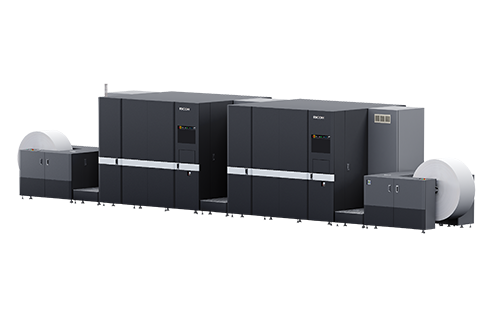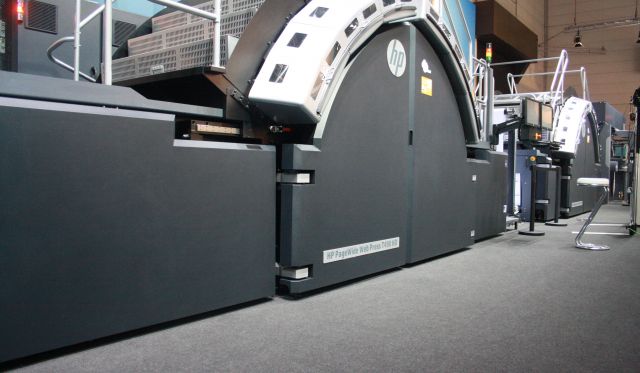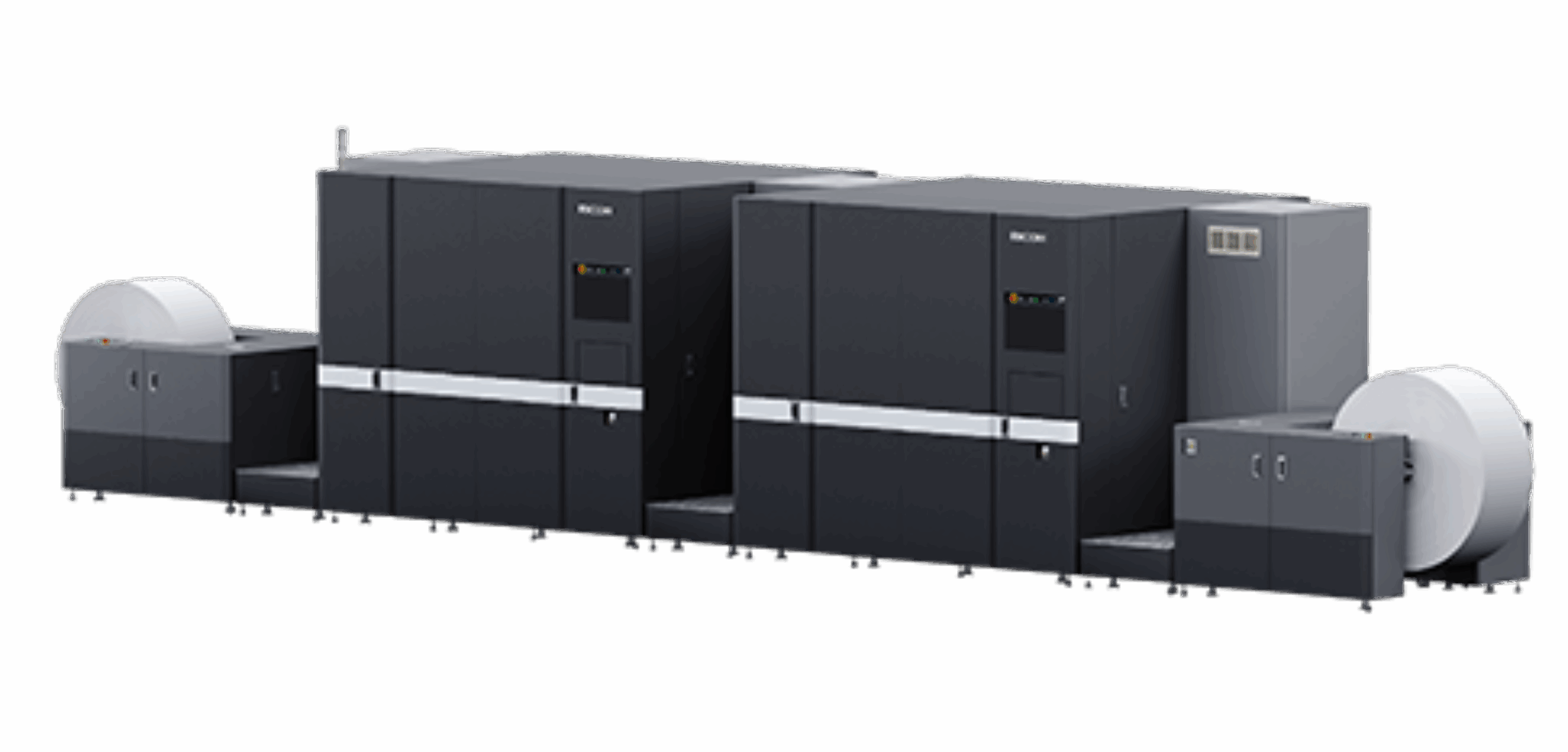Continuous web inkjet printers (SRA3 to B1 format) are transforming commercial, publishing, packaging, and direct mail sectors. Paul Sherfield shares how they offer unparalleled speed, cost-efficiency, and flexibility for high-volume, personalised printing. This technology reduces waste, enables on-demand production, and allows for extensive customisation, proving vital for businesses seeking to innovate and meet diverse market demands.
A market for wide format printing companys?
In the world of commercial printing, technological advancements have always been a critical driver of innovation. One of the most transformative technologies in recent years is the development of continuous web inkjet printing. These systems are particularly well-suited for SRA3 to B1 format printing, common sizes for high-volume commercial and industrial print runs. But what truly sets continuous web inkjet printers apart is their versatility and ability to serve a broad array of markets, each with unique requirements.
In this article we will explore the various markets that benefit from SRA3 to B1-format continuous web inkjet printers. From traditional commercial printers to specialized industries like publishing, packaging, and into the wide format area, we will analyse how these technologies meet the needs of diverse businesses. In doing so, we will explore the technological advantages, operational efficiencies, and business opportunities that arise from adopting inkjet technology in these sectors.
Commercial Print Providers: Speed, Automation, and Flexibility
The commercial print industry is one of the largest users of SRA3 to B1-format continuous web inkjet printers, and for good reason. These printers are designed to meet the needs of high-volume production runs, where speed, efficiency, and quality are paramount. Commercial print providers typically handle a wide variety of print jobs, ranging from corporate marketing materials, brochures, catalogues, and newspapers, to direct mail and even larger signage.
High-Speed Production and Efficiency
One of the standout features of continuous web inkjet printing in the commercial print space is the unparalleled speed. These systems can print at speeds of up to several hundred meters per minute, making them ideal for large-scale, high-volume production. For commercial printers, this translates directly into higher throughput, faster turnaround times, and the ability to meet tight deadlines.

Moreover, because continuous web inkjet printers do not require the use of physical printing plates, they drastically reduce the setup times that are often involved in offset printing. This automation, coupled with the flexibility of the system, enables printers to switch from one job to another with minimal downtime, making it easier to accommodate smaller runs or rush orders alongside longer runs.
Cost-Effectiveness and Lower Waste
For commercial printers, one of the main advantages of continuous web inkjet technology is its cost-effectiveness. While the initial investment in these systems can be high, the long-term operational savings make them an attractive option. Inkjet technology does not require the use of consumables like printing plates, and ink consumption is more efficient compared to traditional printing methods. This translates into lower overall operating costs and higher margins for commercial print providers.
In addition to the reduced costs associated with consumables, continuous web inkjet systems also offer a significant reduction in material waste. The ability to handle shorter print runs without the need for additional pre-press processes means that printers can print exactly what is needed without overproduction. This leads to significant savings, especially in industries where sustainability is becoming a key consideration.
Substrate Flexibility
Another important benefit of SRA3 to B1-format inkjet printers is their ability to print on a variety of substrates. Commercial printers often handle different types of paper, ranging from glossy to uncoated, and these printers are capable of printing on all of them. Additionally, more advanced inkjet systems can print on specialty substrates such as synthetics even textured materials, providing commercial printers with a broader range of applications. This flexibility allows printers to offer a wider variety of products to their clients, from direct mail pieces to high-end marketing collateral.
Publishers and Book Printers: Personalised Print-on-Demand
The publishing industry has experienced significant disruption in recent years, particularly in the realm of print-on-demand (POD) services. SRA3 to B1-format continuous web inkjet printers are at the forefront of this transformation, allowing publishers and book printers to move away from traditional long-run printing in favour of short-run, highly customizable print jobs. This shift is driven by the increasing demand for more personalized content and the need to reduce inventory costs.
Print-on-Demand for Books and Magazines
In the traditional book printing world, large print runs of thousands or even tens of thousands of copies were the norm. Publishers would have to forecast demand months in advance, leading to high upfront costs and potential waste if demand did not meet expectations. However, with the advent of inkjet printing, especially SRA3 to B1-format systems, publishers can now print books, magazines, and other publications in smaller quantities, sometimes even as few as a single copy.

This ability to print books on demand is especially beneficial for niche publishers, educational institutions, and self-publishing authors who may not require a large print run. The availability of affordable, high-quality inkjet printing has democratized the publishing process, making it more accessible to small publishers and independent authors who might otherwise struggle with high costs and logistical challenges.
Cost Reduction and Inventory Management
The biggest advantage of print-on-demand for book printers is the ability to eliminate the need for large, costly print runs. By printing only what is needed, publishers can significantly reduce inventory costs and eliminate the risk of unsold stock.
Additionally, inkjet printers enable publishers to print new editions or make corrections and updates without waiting for a large reprint cycle, which is a significant advantage in an age where information can change rapidly.
For example, academic publishers can print textbooks that reflect the latest research or editions, offering an environmentally friendly and cost-effective alternative to traditional methods. Print-on-demand also allows for quicker access to the market and the ability to test out new books with lower initial investment.
Personalised and Custom Content
As consumer expectations for personalization increase, inkjet technology shines by enabling personalized print runs. In the book publishing industry, this means authors or publishers can offer readers customized books with personal messages, names, or even fully personalized content based on data provided by the customer.
In the magazine publishing world, this opens opportunities for creating special editions for subscribers, including targeted content, custom covers, and even region-specific versions of publications. Inkjet printers can easily handle variable data printing, where each copy can be unique in terms of images, text, or designs, all without the need for additional setup or complex workflows.
Packaging and Labelling: High-Quality, Custom Packaging
In the fast-paced world of consumer goods and retail, packaging plays an increasingly important role. With the demand for more personalized, sustainable, and unique packaging designs, SRA3 to B1-format continuous web inkjet printers are becoming an essential tool for packaging companies. These printers offer an unprecedented level of customization, enabling businesses to produce high-quality packaging that meets the specific needs of brands and consumers.
Short-Run and Custom Packaging
One of the key advantages of inkjet printing in the packaging market is its ability to handle short-run jobs, which is critical in an environment where fast-paced trends and small batch orders are becoming more common. Custom packaging for seasonal promotions, limited-edition products, or regional-specific packaging is made easy with continuous web inkjet systems. Whether it’s a custom box for a new product or a special design for a holiday edition, these printers can handle a wide range of materials such as corrugated cardboard, flexible films, and labels.
Inkjet printers can produce vibrant, high-resolution graphics, sharp text, and even intricate designs that are crucial in standing out on retail shelves. The ability to print on a variety of substrates without the need for additional print plates or setup is a game-changer for packaging businesses, allowing for quick turnarounds and reduced inventory costs.
Branding and Serialization
For many companies, packaging isn’t just about aesthetics; it’s also about building a strong brand identity. SRA3 to B1-format inkjet printers excel at producing high-quality, branded packaging that aligns with a company’s marketing and product identity. Moreover, the ability to integrate variable data into packaging – including serial numbers, QR codes, and barcodes – has made inkjet technology a key player in industries where traceability and anti-counterfeiting measures are critical.
For example, in the food and beverage industry, inkjet printers can apply best-before dates, batch numbers, and other variable data on packaging materials without compromising print quality. The technology is also capable of handling large print runs as well as smaller runs with variable designs, making it ideal for creating personalized or limited-edition product packaging.
Direct Mail and Transactional Printing: Personalization at Scale
The direct mail and transactional printing market has long relied on high-speed printing to produce bulk materials such as invoices, bills, promotional mailers, and catalogues. However, as consumer expectations have evolved, so too has the need for personalisation at scale. SRA3 to B1-format continuous web inkjet printers are perfectly positioned to meet this need, offering high-speed variable data printing that can seamlessly integrate unique customer data into each print piece.
Highly Personalized Marketing Materials
For direct mail providers, personalization is the key to maximizing response rates and engagement. Continuous web inkjet printers can print individual names, addresses, promotional offers, and even customized messages in real time on each piece, all while maintaining a high level of print quality. This level of personalization helps businesses better target their messaging, increasing the effectiveness of direct mail campaigns and driving higher customer engagement.
Moreover, inkjet technology allows for highly flexible print jobs, accommodating everything from variable text and images to different promotional offers tailored to specific customer segments. The ability to print on various substrates, such as glossy or matte paper, envelopes, and even cards, ensures that direct mail campaigns are professional and impactful.
Transactional Printing: Efficient, Accurate, and Secure
In the transactional printing market, inkjet printers are used for producing billing statements, invoices, bank statements, and other critical documents. The need for accuracy, security, and fast processing is essential in this sector, and SRA3 to B1-format continuous web inkjet printers deliver on all fronts. These systems can print large quantities of documents with variable data, such as account information, payment details, and personalized messages, in a highly automated and secure manner.
Moreover, the inkjet technology provides a clear advantage over traditional printing methods in terms of print quality, enabling fine text and barcode printing that ensures accuracy and legibility.
Conclusion: The Future of SRA3 to B1-Format Continuous Web Inkjet Printing
As we have explored in this report, SRA3 to B1-format continuous web inkjet printers offer a multitude of advantages across a wide range of industries, from commercial printing topackaging. By providing the ability to print at high speeds, reduce waste, accommodate personalization, and maintain cost-efficiency, inkjet technology is transforming the way businesses approach large-scale printing.
The future of continuous web inkjet printing looks bright, with ongoing innovations that promise even higher print speeds, more versatile substrates, and improved environmental sustainability. For businesses across various markets—whether in commercial print, publishing, or packaging—the adoption of this technology represents an opportunity to stay ahead of industry trends, streamline operations, and deliver more personalized, on-demand products to their customers.
We believe that the future belongs to businesses that embrace cutting-edge technologies like continuous web inkjet printing, harnessing their full potential to redefine the print landscape and lead the way in innovation. The time to invest in inkjet technology is now, as it provides the agility, scalability, and quality needed to compete in an increasingly fast-paced and personalised world.
